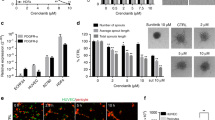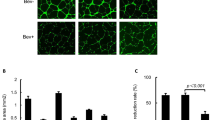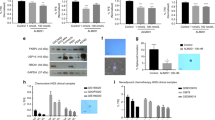Abstract
Angiogenesis is important for growth and progression of ovarian cancers. Squalamine is a natural antiangiogenic sterol, and its potential role in treatment of ovarian cancers with or without standard cisplatin chemotherapy was assessed. Since HER-2 gene overexpression is associated with cisplatin resistance in vitro and promotion of tumor angiogenesis in vivo, the response of ovarian cancer cells with or without HER-2 gene overexpression to squalamine and cisplatin was evaluated both in tumor xenograft models and in tissue culture. Ovarian cancer cells with or without HER-2 overexpression were grown as subcutaneous xenografts in nude mice. Animals were treated by intraperitoneal injection with control vehicle, cisplatin, squalamine or cisplatin combined with squalamine. At the end of the experiment, tumors were assessed for tumor growth inhibition and for changes in microvessel density and apoptosis. Additional in vitro studies evaluated effects of squalamine on tumor and endothelial cell growth and on signaling pathways in human endothelial cells. Profound growth inhibition was elicited by squalamine alone and by combined treatment with squalamine and cisplatin for both parental and HER-2-overexpressing ovarian tumor xenografts. Immunohistochemical evaluation of tumors revealed decreased microvessel density and increased apoptosis. Although HER-2-overexpressing tumors had more angiogenic and less apoptotic activity than parental cancers, growth of both tumor types was similarly suppressed by treatment with squalamine combined with cisplatin. In in vitro studies, we found that squalamine does not directly affect proliferation of ovarian cells. However, squalamine significantly blocked VEGF-induced activation of MAP kinase and cell proliferation in human vascular endothelial cells. The results suggest that squalamine is anti-angiogenic for ovarian cancer xenografts and appears to enhance cytotoxic effects of cisplatin chemotherapy independent of HER-2 tumor status.
This is a preview of subscription content, access via your institution
Access options
Subscribe to this journal
Receive 50 print issues and online access
$259.00 per year
only $5.18 per issue
Buy this article
- Purchase on Springer Link
- Instant access to full article PDF
Prices may be subject to local taxes which are calculated during checkout







Similar content being viewed by others
References
Abedi H, Zachary I . 1997 J. Biol. Chem. 272: 15442–15451
Akhter S, Nath SK, Tse CM, Williams J, Zasloff M, Donowitz M . 1999 Am. J. Physiol. 276: C136–C144
Alvarez AA, Krigman HR, Whitaker RS, Dodge RK, Rodriguez GC . 1999 Clin. Cancer Res. 5: 587–591
Berchuck A, Kamel A, Whitaker R, Kerns B, Olt G, Kinney R, Soper JT, Dodge R, Clarke-Pearson D, Marks P, McKenzie S, Yin S, Bast Jr RC . 1990 Cancer Res. 50: 4087–4091
Chazin V, Kaleko M, Miller A, Slamon DJ . 1992 Oncogene 7: 1859–1865
Chen Q, Williams JI, Anderson M, Kinney WK, Zasloff M . 1999 Clin. Cancer Res. 11: 3768s
Disaia PJ, Sinkovics J, Rulege FN, Smith JP . 1972 Am. J. Obstet. Gynecol. 114: 979–989
Eckhardt SG . 1999 Hospital Pract. 1: 63–78
Ellis RE, Yuan JY, Horvitz HR . 1991 Annu. Rev. Cell. Biol. 7: 663–698
Ferrara N, Winer J, Burton T, Rowland A, Siegel M, Phillips HS, Terrell T, Keller GA, Levinson AD . 1993 J. Clin. Invest. 91: 160–170
Folkman J . 1971 New Engl. J. Med. 285: 1182–1186
Folkman J, Haudenschild C . 1980 Nature 288: 551–556
Gimbrone Jr MA, Leapman SB, Cotran RS, Folkman J . 1972 J. Exp. Med. 136: 261–276
Goldman CK, Kim J, Wong WL, King V, Brock T, Gillespie GY . 1993 Mol. Biol. Cell 4: 121–133
Hellstrom I, Goodman G, Pullman J, Yang Y, Hellstrom KE . 2001 Cancer Res. 61: 2420–2423
Juhl H, Downing SG, Wellstein A, Czubayko F . 1997 J. Biol. Chem. 272: 29482–29486
Keck PJ, Hauser SD, Krivi G, Sanzo K, Warren T, Feder J, Connolly DT . 1989 Science 240: 1309–1312
Kolfschoten GM, Pinedo HM, Scheffer PG, Schluper HM, Erkelens CA, Boven E . 2000 Gynecol. Oncol. 76: 362–368
Kroll J, Waltenberger J . 1997 J. Biol. Chem. 272: 32521–32527
Leung DW, Cachianes G, Kuang WJ, Goeddel DV, Ferrara N . 1989 Science 246: 1306–1309
Luna LG . 1968 Manual of Histologic Staining: Methods of the Armed Forces Institute of Pathology New York, NY: McGraw-Hill
Moore KS, Wehrli S, Roder H, Rogers M, Forrest Jr JN, McCrimmon D, Zasloff M . 1993 Proc. Natl. Acad. Sci. USA 90: 1354–1358
Morales DE, McGowan KA, Grant DS, Maheshwari S, Bhartiya D, Cid MC, Kleinman HK, Schnaper HW . 1995 Circulation 91: 755–763
Mustonen T, Alitalo K . 1995 J. Cell. Biol. 129: 895–898
O'Reilly MS, Boehm T, Shing Y, Fukai N, Vasios G, Lane WS, Flynn E, Birkhead JR, Olsen BR, Folkman J . 1997 Cell 88: 277–285
Ozols RF . 1999 Semin. Oncol. 26: 84–89
Paley PJ, Staskus KA, Gebhard K, Mohanraj D, Twiggs LB, Carson LF, Ramakrishnan S . 1997 Cancer 80: 98–106
Patnaik A, Rowinsky E, Hammond L, Thurman A, Hidalgo M, Siu L, Moczygemba J, Williams J, Holroyd K, Nelson K, Von Hoff D, Eckhardt S . 1999 Proc. Am. Soc. Clin. Oncol. 622: 1999
Pegram MD, Finn RS, Arzoo K, Beryt M, Pietras RJ, Slamon D . 1997 Oncogene 15: 537–547
Petit AM, Rak J, Hung MC, Rockwell P, Goldstein N, Fendly B, Kerbel RS . 1997 Am. J. Pathol. 151: 1523–1530
Pietras RJ, Fendly BM, Chazin VR, Pegram MD, Howell SB, Slamon DJ . 1994 Oncogene 9: 1829–1838
Pietras RJ, Roberts JA . 1981 J. Biol. Chem. 256: 8536–8544
Plumb JA, Strathdee G, Sludden J, Kaye SB, Brown R . 2000 Cancer Res. 60: 6039–6044
Rousseau S, Houle F, Landry J, Huot J . 1997 Oncogene 15: 2169–2177
Schiller JH, Bittner G . 1999 Clin. Cancer Res. 5: 4287–4294
Sebolt-Leopold JS, Dudley DT, Herrera R, Van Becelaere K, Wiland A, Gowan RC, Tecle H, Barrett S, Bridges A, Przybranowski S, Leopold WR, Saltiel A . 1999 Nature Med. 5: 810–816
Sills Jr AK, Williams JI, Tyler BM, Epstein DS, Sipos EP, Davis JD, McLane MP, Pitchford S, Cheshire K, Gannon FH, Kinney WA, Chao TL, Donowitz M, Laterra J, Zasloff M, Brem H . 1998 Cancer Res. 58: 2784–2792
Slamon DJ, Godolphin W, Jones LA, Holt JA, Wong SG, Keith DE, Levin WJ, Stuart SG, Udove J, Ullrich A, Press MF . 1989 Science 244: 707–712
Soker S, Fidder H, Neufeld G, Klagsbrun M . 1996 J. Biol. Chem. 271: 5761–5767
Soker S, Takashima S, Miao HQ, Neufeld G, Klagsbrun M . 1998 Cell 92: 735–745
Steller H . 1995 Science 267: 1445–1449
Teicher BA, Williams JI, Takeuchi H, Ara G, Herbst RS, Buxton D . 1998 Anticancer Res. 18: 2567–2573
Williams JI . 1999 Squalamine-a new angiostatic steroid. In Antiangiogenic Agents Teicher BA (ed.) Totowa, NJ: Humana Press
Williams JI, Weitman S, Gonzalez C, Jundt C, Marty J, Stringer S, Hunt J, Holroyd K, McLane M, Zasloff M, von Hoff DD . 2001 Clin. Cancer Res. 7: 724–733
Wong Y, Cheung T, Lam S, Lu H, Zhuang Y, Chan M, Chung T . 1995 Gynecol. Obstet. Invest. 40: 209–212
Yamamoto S, Konishi I, Mandai M, Kuroda H, Komatsu T, Nanbu K, Sakahara H, Mori T . 1997 Br. J. Cancer 76: 1221–1227
Zebrowski BK, Liu W, Ramirez K, Akagi Y, Milles GB, Ellis LM . 1999 Ann. Surg. Oncol. 6: 373–378
Acknowledgements
We dedicate this article to the memory of Dr James A Roberts (1947–2001), Professor of Gynecologic Oncology at Stanford University, a friend and a leader in ovarian cancer research who provided many helpful discussions. We also thank Dr Kenneth Holroyd, Dr Dennis J Slamon, Dr Mark Pegram and Dr Rebecca Rausch for advice in the execution of this work. This work was supported by grants from the National Institutes of Health (R29CA60835), the United States Department of Defense Ovarian Cancer Research Program (OC990068), and the Stiles Program in Integrative Oncology.
Author information
Authors and Affiliations
Corresponding author
Rights and permissions
About this article
Cite this article
Li, D., Williams, J. & Pietras, R. Squalamine and cisplatin block angiogenesis and growth of human ovarian cancer cells with or without HER-2 gene overexpression. Oncogene 21, 2805–2814 (2002). https://doi.org/10.1038/sj.onc.1205410
Received:
Revised:
Accepted:
Published:
Issue Date:
DOI: https://doi.org/10.1038/sj.onc.1205410
Keywords
This article is cited by
-
A network model for angiogenesis in ovarian cancer
BMC Bioinformatics (2015)
-
Identifying and Predicting the Effectiveness of Carboplatin In Vivo and In Vitro and Evaluating its Combination with Paclitaxel
Indian Journal of Gynecologic Oncology (2015)
-
Gambogic acid synergistically potentiates cisplatin-induced apoptosis in non-small-cell lung cancer through suppressing NF-κB and MAPK/HO-1 signalling
British Journal of Cancer (2014)
-
Dendrogenin A arises from cholesterol and histamine metabolism and shows cell differentiation and anti-tumour properties
Nature Communications (2013)
-
SV40 T/t-common polypeptide inhibits angiogenesis and growth of HER2-overexpressing human ovarian cancer
Cancer Gene Therapy (2011)



